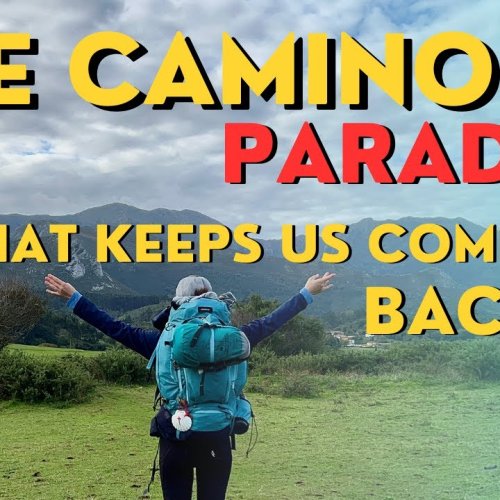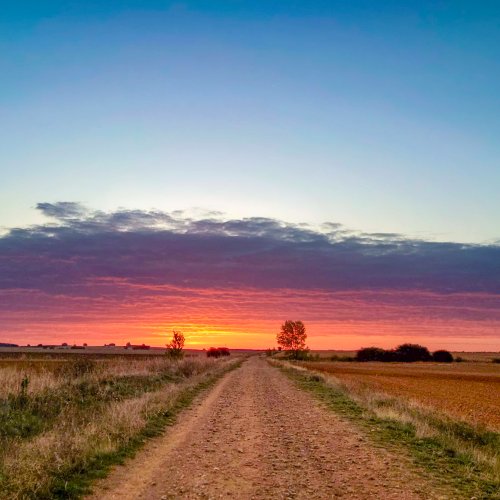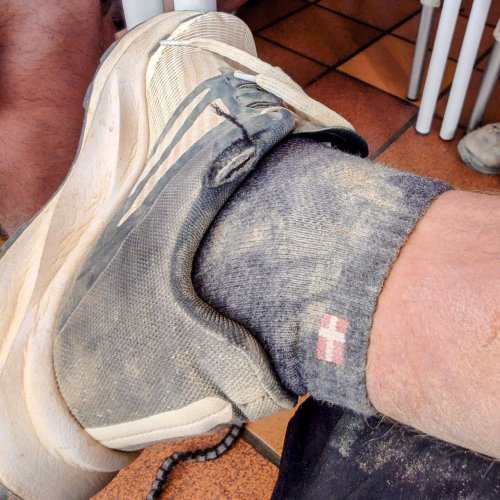- Time of past OR future Camino
- Too many to count!
I would love to share my personal experience with learning from our fabulous forum members, regarding how to manage your feet on the Camino. I have just returned from my customized Camino, doing the Camino Teresiano, connecting to Salamanca from Alba de Tormes on the Camino Natural Via de la Plata for one day, then the Via de la Plata from Salamanca, going by way of the Sanabrés to SdC. A total of about 560 km in 27 days.
I have never, ever NOT suffered from blisters on a Camino and I have done 8 of them!
My first shout out is to Laurie, @peregrina2000, for recommending the trail runner from Altra. I bought the Lone Peak 35 model. I had never before worn a trail runner, only heavier trail hiking, low top shoes. At first I wasn't so sure I liked the Altra, but after days and days and no foot discomfort (except for one niggle which I will talk about in a bit) I thought - these are great! They are the most comfortable shoe I have ever worn. Despite walking in downpours, when my feet did get soaked, I appreciated that they dried out fast. We walked for about a week in the rain, so I appreciated this aspect very much! I was able to keep my feet warm, even though wet, with Darn Tough wool socks. These socks have been my personal favorites for years. The thing I did NOT like about the Altras, is that on the rocky paths, I did not feel as much support as I would have liked, walking with a pack. However, I did use poles on those areas, when they were warranted for extra security. (I did not use poles at all times.) A small compromise, IMHO, for no blisters! I loved how lightweight they were as well!
My second shout out is a thanks to Dave, @davebugg for recommending the Engo Blister prevention patches. I only needed to use them on the toe box area, as it is always my toes that get blisters. They seemed to help change everything. The one patch on each foot lasted me for my entire Camino, although one patch did fold over on a corner after a day walking in pouring rain. I could have changed this patch, but I wanted to see how long it would really last, and I was almost at the end anyway. I also used the anti-friction goop he recommended, the 2Tom Chafe Defender brand. I stopped using this product about 1/3 of the way in, because of the bother (and I always seemed to forget to put it on), without any ill consequence. So after a week, I left it in an albergue. Why carry the weight??
The third and perhaps, for me the most important recommendation of all, and sorry, I have forgotten who recommended it first, is the silicone toe gel caps, used to treat corns and blisters on the toes. I used the Homgaty brand. At my first toe niggle, on the top of my 3rd toe, I immediately started to use the silicone gel cap, every day, from then on. They last surprisingly long, and one gel cap lasted me the entire Camino. I just washed it out and re-used it for more than 3 weeks, I believe! The 'niggle' never turned into a blister, just a callous on the tip of my toe after several days use. My husband ALWAYS gets blisters on his toes that curl under one another, and he refused to wear the gel caps until he actually got blisters on 3 toes! The gel caps (after I drained the blisters and used antiseptic) prevented the blisters from getting worse. In fact, he wore them for the rest of his Camino, also, over 3 weeks and became an instant convert to their efficacy to prevent friction, minimize the pain from them and promote speedy healing! This is a wonderful, wonderful product!
Since I did all these three things differently from past Caminos, I am totally unable to tell if one product was more important in the blister prevention! I actually don't care, as most likely I will continue to use all three going forward! I hope this info helps other peregrinos!!
I have never, ever NOT suffered from blisters on a Camino and I have done 8 of them!
My first shout out is to Laurie, @peregrina2000, for recommending the trail runner from Altra. I bought the Lone Peak 35 model. I had never before worn a trail runner, only heavier trail hiking, low top shoes. At first I wasn't so sure I liked the Altra, but after days and days and no foot discomfort (except for one niggle which I will talk about in a bit) I thought - these are great! They are the most comfortable shoe I have ever worn. Despite walking in downpours, when my feet did get soaked, I appreciated that they dried out fast. We walked for about a week in the rain, so I appreciated this aspect very much! I was able to keep my feet warm, even though wet, with Darn Tough wool socks. These socks have been my personal favorites for years. The thing I did NOT like about the Altras, is that on the rocky paths, I did not feel as much support as I would have liked, walking with a pack. However, I did use poles on those areas, when they were warranted for extra security. (I did not use poles at all times.) A small compromise, IMHO, for no blisters! I loved how lightweight they were as well!
My second shout out is a thanks to Dave, @davebugg for recommending the Engo Blister prevention patches. I only needed to use them on the toe box area, as it is always my toes that get blisters. They seemed to help change everything. The one patch on each foot lasted me for my entire Camino, although one patch did fold over on a corner after a day walking in pouring rain. I could have changed this patch, but I wanted to see how long it would really last, and I was almost at the end anyway. I also used the anti-friction goop he recommended, the 2Tom Chafe Defender brand. I stopped using this product about 1/3 of the way in, because of the bother (and I always seemed to forget to put it on), without any ill consequence. So after a week, I left it in an albergue. Why carry the weight??
The third and perhaps, for me the most important recommendation of all, and sorry, I have forgotten who recommended it first, is the silicone toe gel caps, used to treat corns and blisters on the toes. I used the Homgaty brand. At my first toe niggle, on the top of my 3rd toe, I immediately started to use the silicone gel cap, every day, from then on. They last surprisingly long, and one gel cap lasted me the entire Camino. I just washed it out and re-used it for more than 3 weeks, I believe! The 'niggle' never turned into a blister, just a callous on the tip of my toe after several days use. My husband ALWAYS gets blisters on his toes that curl under one another, and he refused to wear the gel caps until he actually got blisters on 3 toes! The gel caps (after I drained the blisters and used antiseptic) prevented the blisters from getting worse. In fact, he wore them for the rest of his Camino, also, over 3 weeks and became an instant convert to their efficacy to prevent friction, minimize the pain from them and promote speedy healing! This is a wonderful, wonderful product!
Since I did all these three things differently from past Caminos, I am totally unable to tell if one product was more important in the blister prevention! I actually don't care, as most likely I will continue to use all three going forward! I hope this info helps other peregrinos!!


















